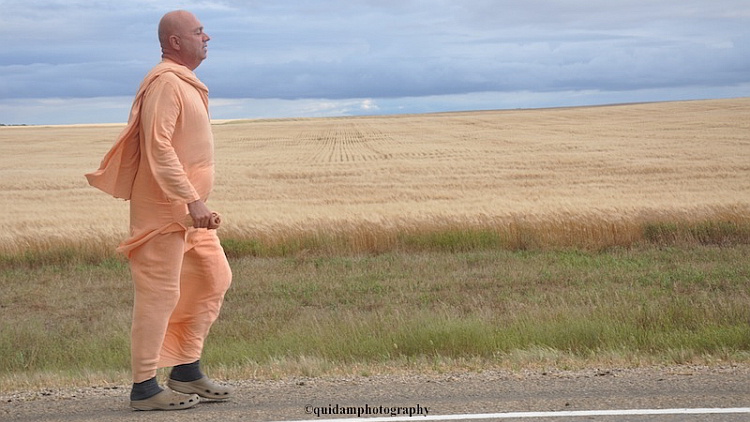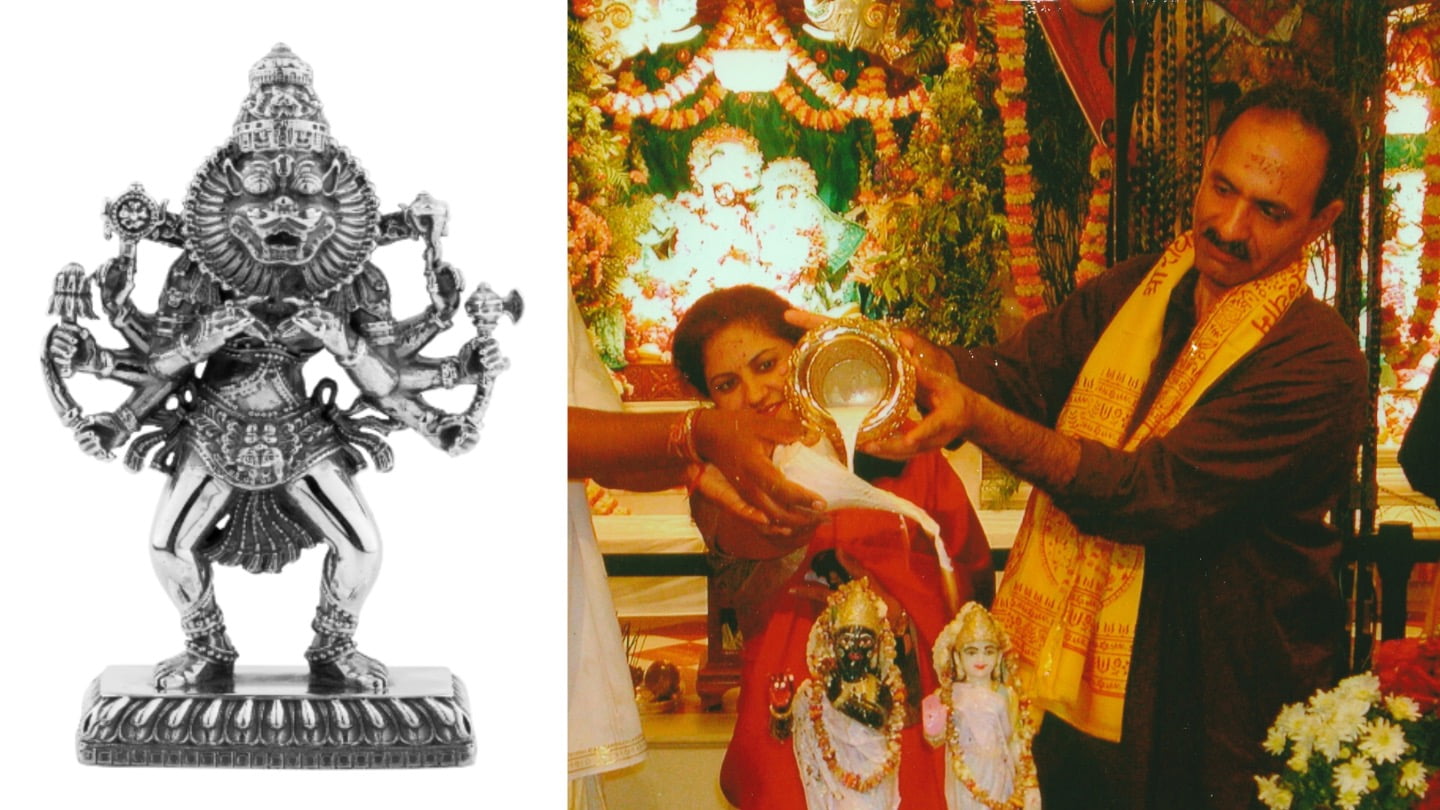Walking Monk Exemplifies the Simple Life
By Madhava Smullen | Sep 22, 2013

In a changing world where buying stuff and watching screens has become more important than human interaction or feeling the sun and air on your skin, walking Hare Krishna monk Bhaktimarga Swami is demonstrating how wonderful the simple life can be.
Well known by now for his pedestrian sojourns across Canada, Bhaktimarga Swami is currently on his fourth cross-country walk.
It all started back in 1996, the 100th anniversary of the birth of Srila Prabhupada, ISKCON’s Founder and Bhaktimarga’s guru.
Bhaktimarga Swami began his walks as a way to address health issues, simply setting out on foot in the city of Toronto, where he lived.
But then he realized that by doing a cross-country meditation walk, he could also make a special offering to his guru Srila Prabhupada.
“I wanted to try out a more sannyasa [renounced] mode of existence — simple living, high thinking, traveling light,” he says.
He also wanted to raise the visibility of Hare Krishna devotees, who had been, as he puts it, “off the radar,” since the 1980s, and give the media and the general public a more positive impression.
Interview with a radio station in Weyburn, SK
In 2002, Bhaktimarga Swami reenacted his 1996 walk for a National Film Board of Canada documentary entitled “The Longest Road”. And in 2003, when the documentary was released and awareness of him and his mission was high, he embarked on his second full walk.
His third walk came after he was hit hard by the passing of his friend and godbrother Bhakti-tirtha Swami in 2005.
By then, he was addicted.
“As a young boy, I used to look at maps of Canada and the world and think, I wonder what this place is like; I wonder what the people and the climate is like,” he says. “I had this bug for travel. And fortunately in Krishna consciousness you’re allowed to do a bit of that. I’m literally embracing the concept that ‘Let’s go to every town and village. Let the Holy Name be heard!’”
Bhaktimarga Swami is doing his current cross-Canada walk in sections, to allow for his many obligations as a Governing Body Commissioner of ISKCON. He began at Cape Spear in Newfoundland, the Easternmost point in continental North America, and headed west across the country, reaching the halfway point last summer.

Taking a break by a hay bale
At the time of writing this article he had just reached the Alberta border, and is about to take a break to attend to some GBC responsibilities. He will then resume walking through Alberta and British Columbia next spring, which will take a month and a half.
Bhaktimarga Swami averages 30 to 35 kilometers per day, striding along in his billowing saffron robes and often chanting the Hare Krishna mantra on his beads — especially in the morning when the highway is quieter.
For the Swami, getting out of the world of concrete and into nature brings the teachings of Lord Krishna to life.
“You see both the soft and harsh sides of nature,” he says. “When Krishna talks in the Bhagavad-gita about the dualities of heat and cold, and of winter and summer seasons, it takes on a whole new meaning.”
For Bhaktimaraga, sometimes this means seeing Krishna in the sun as he rests on a bale of hay; or in the water when he bathes in a lake to cool off from the heat; or in the scented breeze that carries the smell of wheat and pine and fir.
At other times it means understanding the harsh dualities of this world. Bhaktimarga Swami once encountered a large Grizzly bear, which was fortunately scared off by a car. On another occasion, he accidentally stepped on a wasp’s nest and was attacked by an angry swarm. It’s all part of the adventure.
Just an average day on the trail – feeding a bear in Emo, Ontario
As well as encountering nature, Bhaktimarga’s walk is about meeting people. He is not interested in collecting money, proselytizing, or any kind of dishonest approach.
“It’s a friend raiser, not a fundraiser,” he says. “I make lots of friends along the way. And I warm them up to Krishna consciousness by being me. I’m straightforward. I’m in my robes, I tell them my name and what it means — there’s no lying about it.”
Knowing the current widespread distrust of organized religion, Bhaktimarga Swami connects with people by just being “an ordinary guy” with them, and showing them that the path of devotion — aptly, “Bhaktimarga” — is not all about managerial control and scandal. It’s about people.
Thus while he does not hide anything about who he is, he only gives people as much as they ask for and never pushes anything onto them.
“I tell people I’m walking across Canada for the fourth time to promote pilgrimage,” he says. “I tell them walking is really important, you need downtime to meditate and chant and pray — and think of how much your medical bills will go down! I do talk about how we’re on a vegetarian diet and how the Bhagavad-gita is our Bible. But the approach is light. Imagine if I was to bring you a cake and say, ‘Here’s a nice cake, would you like a piece?’ And then when you come forward, I smash it in your face. I don’t think we have to do that with Krishna consciousness. I never felt that method works.”
A motorist pulls over to chat
Bhaktimarga Swami’s approach warms people to him — and he meets all kinds of people.
“I spoke to one man and his family, who despite being cattle ranchers, had been vegetarians for a number of years now,” he says. “And the man said frankly to me, ‘You know, I think where I’m gonna end up is I’m gonna meet this big guy, and he’s blue, and he’s got an extra pair of arms!’”
On another occasion, while Bhaktimarga Swami was walking down the highway, a group of bikers sped past him into the town he had just left. Soon after, they returned and passed him in the other direction, then skidded to a halt and pulled up by the side of the road. Slowly, they all got off their Harleys, loosened their jackets and removed their gloves and helmets, and strode towards him. Bhaktimarga watched them, not sure if he was about to get beaten up.
Then the leader spoke up. “Well, I guess we’re here to get some blessings!” he said. It turned out he had spotted an article about Bhaktimarga in a newspaper in town and wanted to pay his respects to the walking monk.
Trying out a Harley as bikers pull over to get some blessings
Bhaktimarga Swami’s message of pilgrimage, meditation and connecting with nature gets a lot of media coverage wherever he goes.
This is partly down to his one-man support crew, Daruka Das. Daruka takes care of laundry, food, and setting up tents each night, and drives ahead of the Swami in a ‘92 Grand Prix, heralding his arrival in each town.
Carrying with him an Amazon parrot called Billie and a unique ability to create a sensation, Daruka calls organizations and local media and tells them, “My name is Daruka and I am travelling with my parrot, and a monk walking across Canada.”
After he convinces them with some effort that this is not a joke, people are fascinated. Bhaktimarga reaches thousands of people through the media in every town he goes to, and makes presentations called “Tales from the Trail” at schools, museums, and other organizations.
Daruka and his Amazonian parrot Billie
Thrilled to hear that they’re going to be visited by a monk and his parrot, elementary school students pay rapt attention as Bhaktimarga tells stories of his adventures, explains a little about “his order” and Krishna conscious philosophy, and leads them in a kirtan.
Teachers, meanwhile, are delighted to have someone open the children’s minds to spending time outdoors and getting fresh air and sunshine rather than staying inside watching TV or playing video games all day, a major current concern amongst educators.
Bhaktimarga Swami also speaks to older audiences. “We went to Eastend, a town in Saskatchewan with a population of only about 600, and got invited to make a presentation at their museum,” he says. “Most of the people were senior. It was nice to sit in front of these people in their sixties and seventies and eighties and say emphatically, your body may perish, but you’re not going to perish! It’s very profound to their ears to hear this kind of thing.”
A kirtan and presentation at a library in Shaunavon, Saskatchewan
Bhaktimarga Swami is speaking his ages-old message to a world that has changed a lot even since he began his walks in 1996.
Some of the changes are positive. Biased attitudes and prejudices are fading, and the new generation is more open and kind to all minorities and walks of life. There’s a growth in vegetarianism and more conscious living everywhere, even in small towns. And people are more appreciative of the environmentally-friendly, car-free lifestyle that Bhaktimarga Swami is promoting.
However, there is also an increase in urban living and a decrease in rural lifestyles, a stronger dependency on “big box” culture, and less of a sense of neighborliness.
“It’s a little heart-wrenching to see that happening,” says Bhaktimarga Swami. “Even the layout of the towns — there used to be a main street, with shops on both sides. Now you go to the shopping mall and park your car in this big, neverending parking lot, where you don’t really meet people. You just walk in to get things made of plastic made in another country.”
Bhaktimarga Swami also finds it sad that because everything is imported, people are no longer prolific in production and their skill set is becoming reduced.
“It pretty much boils down to being able to drive a car and push buttons on a computer,” he says.
His simple answer to all these imbalances is to give more attention to the spiritual self, rather than just to the body.
“The message is the same for everyone,” he says. “Get more in touch with your spirit. And one nice way to do that is to go for a bit of a walk everyday, and get meditative and introspective.”
Meditating on the banks of a river in Ontario
Bhaktimarga Swami would like to see more people go back to the ancient culture of going on pilgrimage, like the monks of India and Tibet, the Native Americans of North America, and the Celtic and Catholic Cultures of Europe. To walk and find oneself, like the pilgrims of Camino de Santiago in Spain, rather than to going on holiday in Las Vegas or Disney World. To redefine the vacation.
“I would really like to see more devotees do this, too,” Bhaktimarga Swami concludes. “I don’t have a monopoly on it. It’s really for everybody to have and to experience.”
For more information, please visit http://thewalkingmonk.org/.
For a diary of life on the road, visit http://thewalkingmonk.blogspot.com/.





















